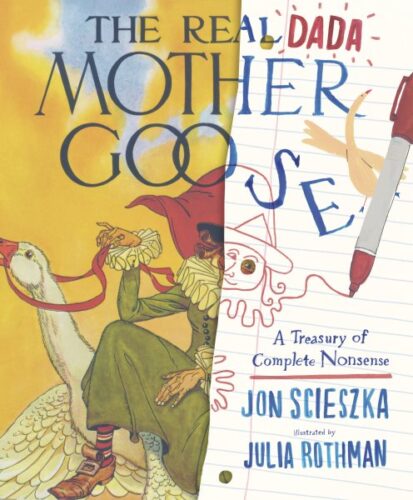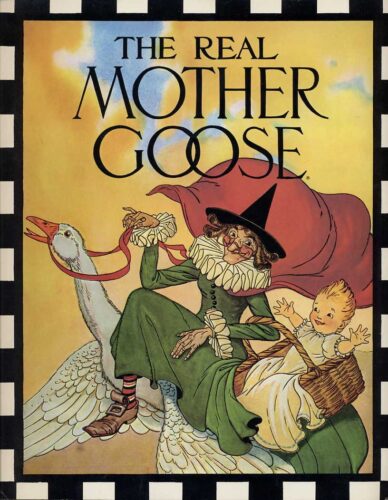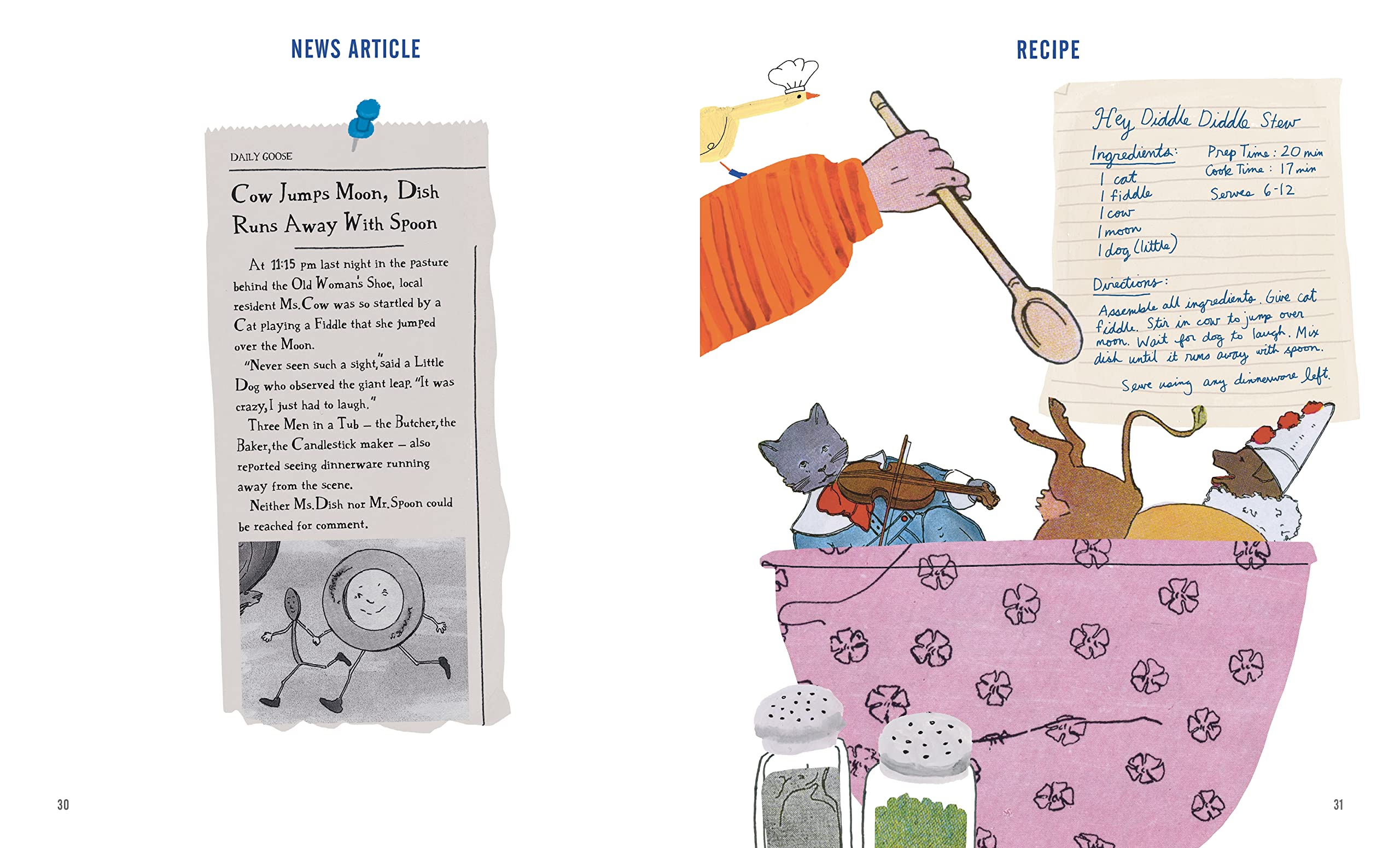Review of the Day: The Real Dada Mother Goose by Jon Scieszka, ill. Julia Rothman

The Real Dada Mother Goose: A Treasury of Complete Nonsense
By Jon Scieszka
Illustrated by Julia Rothman
Candlewick Press
$19.99
ISBN: 9780763694340
Ages 7-12
On shelves October 11, 2022
The human instinct to muck with stuff is strong. The human instinct to keep other people FROM mucking with stuff can be equally strong. Kids like mucking about. They like trying things, often paying shockingly little attention to the potential consequences of their muckage. It is in their desire to mess things up that author Jon Scieszka finds his muse. And, to be perfectly frank, the Dadaists of days of yore probably also felt a bit inspired by young people. Nonsense comes naturally to the young because silliness, and I want you to stay with me on this one, is fun. Now Scieszka has combined some of the things he loves the most (mucking with stuff, Dadaism, children’s instinct to mess things up, language itself) and created what I can only describe as a book that defies description.
Consider for a moment what it would look like to see a perfect amalgamation of Scieszka’s Stinky Cheese Man and his much later Battle Bunny. That’s The Real Dada Mother Goose in a nutshell. Six nursery rhymes from the original The Real Mother Goose Blanche Fisher Wright collection have been taken, mixed-up, stirred up, and given a new lease on life. Now we have six different versions of “Twinkle Twinkle Little Star”. Six different versions of “Jack Be Nimble”. A deep dive into these rhymes reveals an array of ways of telling them. Perhaps you’d like to see an excessive use of similes in “Twinkle Twinkle” (“Like a stick poked in your eye… Like those dumplings called shumai … Like the threat to do or die…”). Hieroglyphs more to your taste? Observe “Hickory Dickory Doc” told with them. With increasing creativity the poems in this book work to wow. Backmatter includes definitions and history to all the different forms, as well as a smart encapsulation of the Dada movement and even the lives of Mother Goose and Blanche Fisher Wright (what we know of them).
ADVERTISEMENT
ADVERTISEMENT

In their heyday, nursery rhymes were a staple in a lot of American homes. Got a baby coming? Here, let me hand you the necessary tome. And Scieszka’s instinct to zero in on Blanche Fisher Wright’s 1916 edition of The Real Mother Goose was a particularly inspired move. First off, if he wanted to make a book like this, he needed to find something in the public domain. That means, finding something published before 1923, generally speaking. Next, he needed a book that would be widely recognizable. I’m not saying he couldn’t have just grabbed any old nursery rhyme book. But you would probably be amazed at how many people walking around today actually had some reprint of The Real Mother Goose as children. I did. I couldn’t have told you that if I hadn’t seen the cover of The Real Dada Mother Goose, but the minute I made out the cover it gave me a visceral sensation. As a kid, I remember staring at the original cover. The Mother Goose featured here is an old lady, as you’d expect, but there’s mischief in that woman’s eye. Look at her. She’s got on a witch’s hat and a friggin’ cape like a superhero. Meanwhile she’s riding a gigantic goose (sidesaddle, of course, being a lady and all) with a random baby in a basket flung off one arm because, why not? You get the distinct impression that this Mother Goose is not only on board with Scieszka’s plans to reinterpret her nursery rhymes, she might take all the credit for giving him the idea in the first place!
Can we talk a bit about the fact that Dadaism was formed in 1916 and that The Real Mother Goose, the very book that Scieskza and Rothman are mucking with here, was published that very same year? It blows my mind. Dadaism feels oddly contemporary as a concept. During the early days of COVID, for example, my daughter’s theater production decided to do Dada theatrical pieces where each kid was socially distanced on a path in the woods and attendees stopped to hear their bits. But Blanche Fisher Wright is tapping into something ancient and classic with her book. Nursery rhymes have been around for such a long time, and for a great while her book was the #1 one-stop-shop for a lot of them (at least until Arnold Lobel and Tomie de Paola started getting in on the action). It makes perfect sense that Jon Scieszka would turn from fairy tales to nursery rhymes. They’re woven so closely into the fabric of American society. All the more reason he selected the rhymes that he did for this book. They’re all mighty famous, but even if a kid is coming to them for the first time he makes sure to always write out the original first. After all, how can you truly take something apart if you never saw it put together in the first place?

For a while there, there was a trend to create secret code books for kids. I’d buy them for my children’s library and they always did moderately well. The trouble is that they never really connected to kids emotionally. Oh, I’m sure some of them were beloved, but they also blended together. It was hard to distinguish one from another. Now there is nothing on the outside of this book to indicate to kids that it is packed full of codes. That’s part of the fun. The cover looks wackadoodle enough to entice them, but it’s only when they start paging through on their own that they figure out what it’s up to. What’s interesting is that they just keep turning those pages, always wondering what Scieszka will come up with next. The fact that he never disappoints and often makes them laugh out loud is testament to his skills.
As for the illustrator, Rothman is such an interesting choice for this book. I was under the distinct impression that I was unfamiliar with her work when I first picked it up. Then I did a bit of prying and found (to my infinite delight) that she was the artist behind none other than one of my favorite contemporary picture books, Can I Eat That? by Joshua David Stein. In that, as in so many of her other books, Rothman utilizes thin pen lines to perfectly convey food that you should or should not (under any circumstances) eat. Indeed much of her art in the past has been this highly trained, thin-tipped, series of exercises in gross reality. With Dada Mother Goose she uses her powers for . . . not good, exactly. More, the spirit of the endeavor. For example, in this book she is called upon to not only reinterpret these poems but complement whatever folderol that pops into Jon’s brain. This actually gives her a fair amount of leeway. So for the boring version of Humpty Dumpty she takes Blanche Fisher Wright’s original eggman (koo koo ka choo) and reworks his eyes, mouth, and hands so that he’s now combing his Homer Simpson-esque hair. She has also created a whole regiment of King’s soldiers (not simply “men”) who don’t have much to do. And that’s the brilliance of this partnership. In the past, Jon would rely on Lane Smith to bring his imaginings to life. Here, Rothman fills the same niche, but with her own spin. There’s something about seeing these classic characters used again and again and again and again in different ways that makes a huge impression on you. It’s like she’s taken something sacred like a Mona Lisa and put a mustache on it. Say, there’s a notion . . .

A couple weeks ago I was at my in-laws house and my mother-in-law happened to pull out Wright’s original The Real Mother Goose which I snatched up almost immediately. When I posted a picture of myself with it on Instagram the comments all said the same thing. “I had that book when I was a kid!” “I remember that book!” “That book was in our house!” I was stunned by the overwhelming amount of love the original engendered. It didn’t stop there either. I brought the book home and put it on my coffee table and two different moms on two different days, either dropping off or picking up their kids, cooed when they saw it and said they remembered it too. In other words: Jon Scieszka is a genius. He’s found a way to entice both adults (through the magic of nostalgia) AND kids (through the magic of hilarity) with the same book. When a book doesn’t slot into easy categorization it can run the danger of never finding its audience. Still, I firmly believe that the audience for this book will find it without difficulty. As smart as it is funny, this is the Mother Goose book we didn’t know we’d been waiting for all this time.
On shelves October 11th
Source: Final copy sent from publisher for review.
Filed under: Best Books, Best Books of 2022, Reviews, Reviews 2022
About Betsy Bird
Betsy Bird is currently the Collection Development Manager of the Evanston Public Library system and a former Materials Specialist for New York Public Library. She has served on Newbery, written for Horn Book, and has done other lovely little things that she'd love to tell you about but that she's sure you'd find more interesting to hear of in person. Her opinions are her own and do not reflect those of EPL, SLJ, or any of the other acronyms you might be able to name. Follow her on Twitter: @fuseeight.
ADVERTISEMENT
ADVERTISEMENT
SLJ Blog Network
Name That LEGO Book Cover! (#53)
K is in Trouble | Review
Fighting Public School Book Bans with the Civil Rights Act
ADVERTISEMENT








Oh boy, girl–as a stinky cheese head, I can’t wait for this Scieszka-ism. Especially if it gets the Bird Blessing. Thanks!